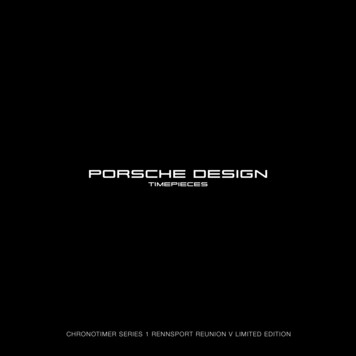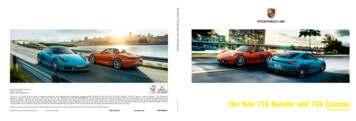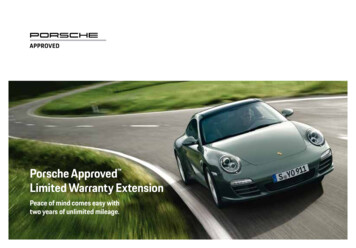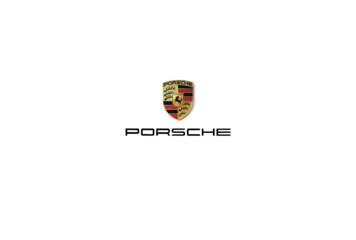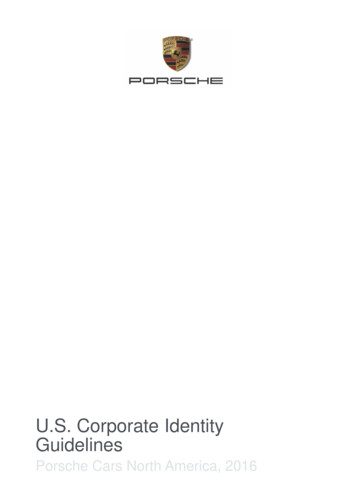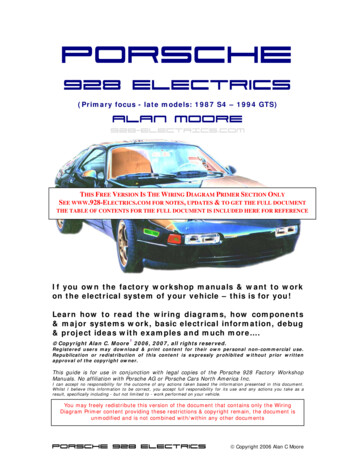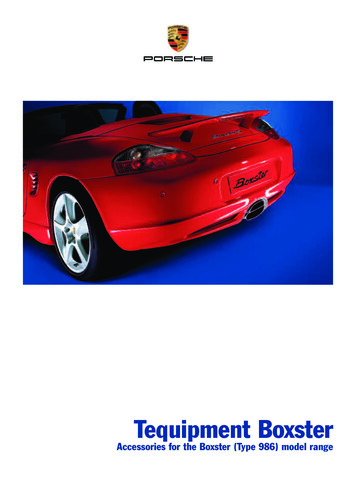
Transcription
Technical ManualModel 2010
PrefaceThis technical information will give you the possibility to reference data,adjustment values and working procedures and make the maintenanceand repair work on the vehicle easier.We wish you every success with your GT3 CupDr. Ing. h.c. F. PorscheAktiengesellschaftVertrieb Sonder- und Rennfahrzeuge
Race car 911 GT3 Cup Modell 2010This car is specifically designed for participation in one-make cupcompetitions.For obvious reasons, measurements referring to bodywork dimensionsof the production cars cannot be used as reference.Porsche accepts no guarantee that the vehicle conforms to theregulations.The car can not be registered for road use and does not comply withGerman road traffic regulations.Illustrations, descriptions and schematic drawings serve exclusively aspresentation for the text. Porsche Motorsport accepts no liability for thecompleteness and conformity of the contents of this brochure withrespect to the legality of the current regulations.
Contents1.CONTACTS42.GENERAL TECHNICAL DATA52.1.Dimensions52.2.Weight53.ENGINE63.1.Engine technical data63.2.Engine power and torque curves73.3.Engine lubrication83.4.Engine cooling system123.5.Induction system183.6.Throttle butterfly183.7.Working on the engine223.8.Engine component tightening torques353.9.Engine mileage364.FUEL AND EXHAUST SYSTEM374.1.Fuel system374.2.Exhaust system385.GEARBOX425.1.Technical data gearbox425.2.Gearbox layout435.3.Dog-ring hub445.4.Gearbox lubrication455.5.Ratio chart455.6.Gear recognition465.7.Changing gear475.8.Differential491
5.9.Clutch505.10.Working on the gearbox535.11.Tightening torques gearbox755.12.Gearbox mileage756.SUSPENSION766.1.Front suspension766.2.Rear suspension806.3.Basic wheel alignment836.4.Wheel alignment procedure846.5.Working on the suspension916.6.Tightening torques suspension926.7.Sachs damper service information1027.WHEELS1048.BRAKE SYSTEM1068.1.Technical data brake system (steel)1068.2.Technical data brake system (PCCB)1068.3.Brake force distribution (brake balance)1078.4.Brake caliper1148.5.PCCB brake disk information1148.6.Tightening torques brake 69.3.Rear wing1179.4.Fire extinguisher system1189.5.Air-jack system1202
3.Steering wheel12210.4.Centre console12410.5.Shift Light Module12510.6.MoTeC Dash12610.7.Car sensors13010.8.Engine Control Unit (ECU)13210.9.Relay- and fuse assignment13310.10.Fuse carrier13411.CAR MAINTENANCE13511.1.After approx. 200 km and/or first test13511.2.After every session13511.3.After every race weekend (sprint)13611.4.After 3 - 4 race weekends (sprint)13611.5.After 20 respectively 30 hours running time13611.6.After 50 hours running time1363
1. ContactsInternational One Make CupsMr Michael Dreiser0711 911 82684AssistantMrs Juliane Gründl0711 911 82683Technical supportMr Marcus Stolzenthaler0711 911 82498Mr Steffen Höllwarth0711 911 89922Fax: 0711 911 82920Porsche Mobil 1 SupercupMr Jens Walther0711 911-84042AssistantMrs Jennifer Biela0711 911-84096Technical supportMr Stefan Rometsch0711 911-84613Fax: 0711 911 82920Porsche Carrera Cup GermanyHr. Helmut Greiner0711 911 84074AssistantMrs Andrea Hagenbach0711 911 84041Technical supportMr Rainer Sauter0711 911 84994Fax: 0711 911 82920Sport parts salesMr Friedrich Weseler0711 911 89854Mr Karlheinz Kienle0711 911 82923Mr Klaus Lenzner0711 911 82423Mr Christian Müller0711 911 89175Mr Salvatore Scozzaro0711 911 83738Mr Ulrich Wöhr0711 911 83363Mr Emanuel Donno0711 911 82687Fax: 0711 911 828084
2. General technical dataEngine typeM 97/78Gearbox typeG 97/63Numbers of gears2.1.2.2.sequential 6DimensionsLength (w/o spoiler edge)[mm]4423Width across front axle[mm]1787Width across rear axle[mm]1859Wheelbase[mm]2353Dry weight[kg]Weightappr. 1200With steel brakes, without front exhaust silencer5
3. EngineThe engine is based on the power unit fitted to the road approved911 GT3 and is specially modified for motorsport purposes.The engine is fitted with a dry sump lubrication system; the oil tank ismounted directly on the engine. The engine oil is cooled by an oil-waterheat-exchanger integrated in the cooling system.3.1.Engine technical dataEngine typeM97/78DesignSix-cylinder boxerCylinders6Bore[mm]102.7Stroke[mm]76.4Cubic capacity[cm³]Compression ratio3797approx. 12 : 1Maximum revs[rpm]8,500Inlet valve diameter[mm]41Inlet valve liftPoint of maximuminlet valve liftExhaust valvediameter[mm]12.0[mm]35.5Exhaust valve liftPoint of maximumexhaust valve lift[mm]12.0Cooling mediaLubrication[ ][ ]105 after TDC110 before TDCWater cooledDry sump lubricationOil-water heat-exchanger6
3.2.Engine power and torque curves7
3.3.Engine lubricationThe 911 GT3 is equipped with a dry sump lubrication system. The oil tankis mounted to the engine.The engine oil is cooled by an oil-water heat-exchanger mounted on theengine.3.3.1. Engine oilMobil 1 0W - 40Mobil 1 5W - 408
3.3.2. Engine oil system1 – Oil tank9 – Piston cooling2 – Pressure pump10 – Timing chain tensioner3 – Safety valve11 – Camshaft4 – Oil filter12 – Hydraulic valve lifter5 – Pressure sensor13 – Camshaft housing scavenge pump6 – Oil-water heat-exchanger14 – Crankcase scavenge pump7 – Pressure relief valve15 – Balance shaft8 – Crankshaft9
3.3.3. Checking the oil levelThe engine oil temperature must be over 80 C and the engine running atidle speed (approx 2,000 rpm) to measure the oil level correctly. The oillevel must be between the two marks on the dip-stick. The distancebetween the two marks corresponds to 1 litre of engine oil.An excessively high oil level can lead to oil entering the inductiontract.If engine oil is added it should be noted that this oil only flows slowly intothe oil tank through the dip-stick guide sleeve. Therefore the oil levelshould only be measured again after waiting for a few minutes.The engine oil level must be checked regularly and correctedwhen necessary especially when the engine is new. Oil pressuresignal drop outs in the MoTeC data logging are a clear indicationfor low oil level. Therefore the oil pressure must be carefully andregularly monitored. (e.g. with MoTeC). The MoTeC oil pressurealarm is active if the oil pressure falls below 2.5 bar for at leastone second at an engine speed of 2,500 rpm or greater (for aminimum of two seconds).3.3.4. Filling capacitiesNew engine:11.0 lWith oil filter change:8.3 lWithout oil-filter change8.1 l10
3.3.5. Digital oil level displayAn optional oil level display is available (997.641.139.9A):The car wiring loom is already prepared for use of this display. Theconnector for the display is located in the area of the rear side-window onright-hand side of the car.In addition, the oil level sensor 996.606.140.00 is necessary fordisplaying the oil level. The sensor is plugged in the oil tank.11
3.4.Engine cooling systemThe GT3 Cup cooling system is a standard cooling system optimised foruse in a race car.3.4.1. Scheme drawing1 – Left-hand side cooler4 – Gearbox heat-exchanger2 – Centre cooler5 – Engine heat-exchanger3 – Right-hand side cooler6 – Cooling water expansion tankdi – Bleed throttle3.4.2. ThermostatThe thermostat fitted starts to open when the water temperature exceeds60 C. The thermostat is completely open from 72 C.12
3.4.3. Cooling fluidThe cooling system if filled with 11 litres of water and 11 litres of antifreeze when delivered. The coolant remains fluid to temperatures of -30 Cin delivery specification with this water/anti-freeze ratio.For all race events Porsche Motorsport recommends that the factory filledengine coolant is replaced by 20 litres of water and 2 litres of anticorrosion additive (part number. 997.106.907.90), which protects thewater galleries and other cooling system parts from corrosion, reducescavitation, lubricates the water pump and increases the boiling point ofthe cooling water.For Cup races supporting Formula 1 events the coolant must bechanges as described below: Approx 20 litres water plus minimum2 litres anti-corrosion additive part number 997.106.907.90.3.4.3.1.CapacityApprox 22 litres13
3.4.4. Filling the cooling systemA quick-release coupling is integrated in the engine bay in the area of theexpansion tank. The water system can be filled and bled quickly andsafely via this coupling – after an engine change for example.Quick release couplingWhen the water system has reached its operating temperature,the expansion tank cap should under no circumstances be openedand the pressure released. Since the operating temperature hasalready been achieved the water pressure cannot be built upagain. This system pressure is necessary to increase the coolantboiling point.14
Valves in the expansion tank allow the exhaust of steam at a pressure of1.4 bar, and the release of water at a pressure of 1.8 – 2.0 bar.The bleed valve in the standard production car improves the initialreaction from the heating system; the valve remains open in the race carsystem allowing the system to be bled continuously.A special filling system available from Sobek should be used to fill thewater system. The filling system consists of an electric pump that pumpswater from a tank into the system.Bernd Sobek – MatternFliederstr. 10D – 69517 GorxheimertalTel 49 (0) 6201 2051Fax 49 (0) 6201 21834www.sobek-motorsporttechnik.eu15
Filling the system should be carried out as follows: Disconnect the quick release fittings in the engine bay andconnect the corresponding fittings with those of the filling system Switch on the pump, the system will be filled The device must run for ten minutes to guarantee that the systemis correctly filled and bled Warm-up the engine (80 C) and, if required, fill the reservoirto the maximum level with the filling device still attached The expansion tank cap must be closed throughout theentire procedure3.4.4.1.Filling the cooling system with engine at normal operating temperature:A special filling system to fill the engine water system when the engine isat normal operating temperature is also available from Sobek. Thisappliance consists of a fluid reservoir with a coupling. The reservoir ischarged with a pressure of 2.5 – 3.0 bar.The system filling procedure must be carried out as follows: Disconnect the quick release fitting in the engine bay and connectthe filling system coupling to the corresponding end of the quickrelease fitting. The system is filled via the expansion tank.16
3.4.4.2.Filling the cooling system with pre-heated waterA special filling system to fill the engine water system when the engine isat normal operating temperature is also available from Sobek.17
3.5.Induction systemVacuum actuatorReso 1 (su)Vacuum actuatorReso 2 (su2)3.6. Four-stage resonance induction system Activated by vacuum actuator resonance valves (x2)Throttle butterfly1.) Adjuster screw2.) Lock nut3.) Threaded bush4.) Potentiometer Mechanical single throttle butterfly without by-pass Idle speed set via adjuster screw18
3.6.1. Throttle cableCompensation of the throttle-cable length is made by the spring fitted inthe connecting piece. To achieve this the spring is tensioned and/or untensioned by rotating the connection piece.3.6.1.1.Tension-free setting of the throttle cableBefore calibrating the throttle-butterfly potentiometer the throttle cablemust be set “tension-free”:1.Rotate the throttle cable in the direction “auf” on the connectingpart behind the driver seatcloseopen2. Press the two halves of the connecting part together3.Rotate the throttle cable in the direction “zu”123The throttle cable has play in this position. Tasks such as throttle butterflyreset can now be carried out.19
3.6.1.2.Play compensationTo remove throttle cable follow the procedure described below:121. The throttle cable is tensioned automatically by the lengthcompensation spring2. To finish, rotate the connecting part in the direction “close” till themarking lugs on both parts of the connecting part are alignedThe throttle cable is tensioned automatically by the length compensationspring3.6.2. Throttle butterfly potentiometer calibrationThe throttle butterfly potentiometer must always be recalibrated if: ECU was changed or reprogrammed Engine was changed Throttle butterfly potentiometer was changed Implausible throttle butterfly position values are displayedThe following steps must be taken to calibrate the potentiometer:1. Adjust the throttle cable so it is tension free (see3.6.1.1)2. Disconnect the throttle cable from the cam-disc3. Loosen the idle adjustment screw 1.)4. The cam-disc must now rest on the threaded bush bration of the throttle butterfly is made in thisposition (reset the throttle butterfly angle to 0 )5. This calibration is made via Bosch Modas a.) or theMoTeC Dash b.)20
a.) In Modas on the ‘Throttle’ page (in Engine F1) activatethe button ‘Set Throttle’ throttle angle wdkba w shows 0 b.) Switch to Warmup mode, press and hold the ‘Display’ and‘Alarm’ buttons for approx. 3 seconds till the ‘Reset’ appearsin the display and THR BO goes to 0 HIGHBEAMFLASHERSPEEDWIPERDISPLAYALARM6. Screw the idle adjustment screw 1.) into the threadedbush 3.) till a throttle value of appr. 6.5 (THR BO inDash, wdkba w in Modas) is displayed7.The throttle value must NOT exceed 9 at idle (THR BOin Dash, wdkba w in Modas)8. Lock adjustment screw 1.)9. Reconnect throttle cable to cam-disc10. Tension the throttle cable (see 3.6.1.23.6.1)3.6.3. Full throttle adjustmentAdjust the throttle pedal stop-screw so that full throttle equals 80 /- 2 (THR BO in Dash, wdkba w in Modas)Attention: Only the adjustment screw under the throttle pedalshould be used to set full throttle. It is essential at full throttle, i.e.when the throttle pedal is touching the stop, that there is sufficientplay in the throttle cable on the engine and that the throttle cablemovement is limited by the adjuster screw and NOT by the cable.If the full throttle value is too high it is possible that mechanicaldamage or a sticking throttle can occur.21
3.7.Working on the engine3.7.1. Connecting-rod bolt mounting instructions1. Thoroughly clean the mating faces, bolt threads and the tappedbores2. Smear the threads and bolt head mounting faces with engine oil3. Initial tightening torque:30 /- 3 Nm4. Final tightening torque:62 /- 2 torque angle5. Resulting elongation:0.200 /- 0.015 isassembly.The joint surface must NOT be damaged.As the connecting rods have a coated surface care must be taken that novisible damage occurs to the connecting rod surface when dismantlingand assembling the engine. The connecting rods must NOT be polished.22
3.7.2. Mounting the cylinder headThe following procedure should be adhered to when mounting the cylinderhead:1. Lightly oil the threads and mating faces2.Tighten the bolts initially to 30 Nm in the following sequence,and then wait 15 minutes3. Completely loosen the bolts in the reverse sequence4. Initially tighten the bolts to 20 Nm, before finally tightening to120 torque angle3.7.3. Flywheel tightening procedure3.7.3.1.With used flywheel:1. Loosen and remove the bolts2. Replace with new bolts part number 930.102.206.003. Tighten the new bolts to 30 Nm (tighten sequence diagonallyopposed)4. Retighten bolts to 30 Nm and an additional 45 torque angle(tighten sequence diagonally opposed).3.7.3.2.With new flywheel:1. Because a new flywheel ‘settles’ it should be mounted initiallyusing used bolts as described above.2. Replace with new bolts part number 930.102.206.003. Tighten the new bolts to 30 Nm (tighten sequence diagonallyopposed)4. Retighten bolts to 30 Nm and an additional 45 torque angle(tighten sequence diagonally opposed).23
3.7.4. Set valve timing3.7.4.1.3.7.4.2.Valve timingPoint of max inlet valve lift (EM)105 after TDCPoint of max exhaust valve lift (AM)110 before TDCSpecial toolsPorsche Motorsport recommends use of the following special tools toadjust and set the valve timing of the 911 GT3 CupBase plate cylinder 1:996.721.549.90Base plate cylinder 2:996.721.550.90Guide element EM/AM 110/110:996.721.551.9AGuide element EM/AM 105/115:996.721.551.93Degree wheel crankshaft:996.450.131.00Chain tensioner:000.721.940.10Setting jig TDC:996.721.511.91Retaining key timing chain sprocket:996.721.513.9024
3.7.5. Removing and fitting the crankshaft seal – pulley-side3.7.5.1.Special toolsPorsche Motorsport recommends use of the following special tools toremove and fit the pulley-side crankshaft seal:3.7.5.2.Retaining key pulley:000.721.973.20Adapter retaining key pulley:000.721.973.21Press tool crankshaft seal:000.721.216.40Spacer for press tool:000.721.979.71Protective cap crankshaft:000.721.979.70Removal1. Remove the pulley from the crankshaft using the special tool000.721.973.20 with the retaining key extension 000.721.873.202. Check the locating dowel on the pulley for damage and replace ifnecessary3. Centre-punch the steel ring in two points offset from one another by180 25
4. Drill two holes (Ø 2 mm) at the centre punched points5. Screw the threaded-end of a commercially available slide hammer -1into the drilled holes. Carefully remove the seal -2- by swapping the slidehammer alternatively between the drilled holes6. Make a drill jig according to the following sketch (paper our thickcard). All dimensions in millimetre26
7. Slide the drill jig up to the seal on the crankshaft flange and positioncorrectly8. Coat the drill bit (Ø 2 mm) with extremely viscous grease9. Drill at the specified points10. Screw the pointed end of a commercially available slide hammeralternatively into the two holes and pull-out the seal.11. Remove swarf12. Thoroughly clean the flange with a cleaning solvent or acetone3.7.5.3.Installation1. Fit the press tool 000.721.216.40 with spacer 000.721.979.712. Always fit the crankshaft seal dry, DO NOT use grease3. Push the protective cap 000.721.979.70 onto the crankshaft27
4. Push the new crankshaft seal -1- onto the crankshaft flange (mountingposition: steel disc to pulley)5. Push the press tool (see 1) onto the crankshaft flange and fit thehexagon-head bolt -3- (17 mm AF)6. Tighten the hexagon-head nut -4- till the spacer-2- touches thecrankshaft flange7. Leave the tool fitted for approximately two minutes so that the sealseats correctly8. Loosen the hexagon-head bolt -4-, remove the hexagon-head bolt andtool9. Remove the protective cap28
3.7.6. Removing and fitting the crankshaft seal – crankshaft side3.7.6.1.Special toolsPorsche Motorsport recommends use of the following special tools toremove and fit the flywheel side crankshaft seal:3.7.6.2.Pressure pad:000.721.912.60Seal extractor jig:000.721.971.90Removal1. Drill two holes (Ø 2,5 mm), 180 opposed from one another, into themetal ring of the crankshaft seal. Never lever out the seal!2. Screw the threaded end of a commercially available slide-hammeralternatively into the holes and extract the metal ring evenly.29
3. After extracting the metal ring the actual seal remains in thecrankcase. Under no circumstances whatsoever must this be levered out.4. Carefully remove the drill swarf5. Carefully drill two further 2.0 mm holes (arrows) as close as possibleto the corners (metal body) of the seal.6. A thrust ring is fitted behind the crankshaft seal which should preventthe possibility of the seal being fitted inclined. Aluminium swarf which mayappear during drilling should be carefully removed.7. Remove the seal, there are two procedures for thisa.) Screw the threaded end of the slide hammer alternatively into thebores and extract the seal evenly.b.) Screw in two self-tapping screws and extract evenly with the clawfitting of a slide hammer30
8. Carefully remove the swarf and oil residue from the crankshaft bore3.7.6.3.FittingIf visible carefully remove small edges or burrs from the crankshaft flangechamfer with an oil stone, afterwards carefully clean the crankshaft journaland the crankcase bore (use cleaning solvent or acetone with a clean, lintfree cloth).The crankshaft flange sealing face must not, under any circumstances, betreated with emery cloth, polish compounds or wire brushes. Removecorrosion on the crankshaft flange with a special metal polish wad.Afterwards carefully clean the crankshaft flange with acetone or cleaningsolvent.31
1. Fasten the insertion-jig base plate 000.721.971.90 hand tight andevenly to the crankshaft flange using the hexagon-head boltThe crankshaft seal should always be fitted dryDo not touch the micro sealing lipThe steel ring must face towards the technician during assembly2. Fit the insertion-jig magnetic cone to the base plate, fit the crankshaftseal to the cone and carefully push it onto the base plate3. Fit the seal dry32
4. Remove the magnetic cone and using the pressure piece000.721.912.60 push the crankshaft seal in a coplanar position.5. Fasten the insertion jig mounting dome 000.721.971.90 to the baseplate, for this purpose tighten the mounting dome hexagon-head bolt byhand33
6. Push the crankshaft seal onto the crankshaft flange by rotating theinsertion nut clockwise till the mounting dome butts completely on thecrankshaft flange mounting surface.7. Leave the assembly tools for one or two minutes in the final position,the seal and sealing lip position themselves as a result.8. Loosen the inserting nut and remove the hexagon-head bolt of theinserting jig, remove the jig and unscrew the base plate9. Check the fitted position of the seal, for this purpose measure thedistance at four points from the crankshaft flange to the level surface ofthe steel ring (arrow).34
Measurement depth is approximately 5 mmMaximum permissible misalignment is 0.5 mm10. If the comparable values exceed the maximum difference use theinsertion jig again to press home3.8.Engine component tightening torquesComponentBoltdimensionsTightening torque[Nm]Crankshaft and crankcaseConnecting rodM10 x 1.25see 3.7.1Oil pumpM823Bolt / nut crankcaseM823V-belt pulley to crankshaftM14 x 1.5170Plug screw for pressure release valveM18 x 1.540Oil drain bolt, crankcaseM20 x 1.550Water drain bolt, cylinders 1-3M10 x 110Water drain bolt, cylinders 4-6M16 x 1.510FlywheelM10see 3.7.3M10see 3.7.2Cylinder headCylinder head boltCamshaft housingCamshaft housing on cylinder headM8Initial torque: 23Final torque: 28Anti-knock sensorM823Spark plugsM12 x 1.2520Spark plugs should only be tightened a maximum of five timesCamshaft wheel on camshaftM12 x 1.530 90 Timing chain case to crankcaseM823Valve cover to camshaft housingM69.7Timing chain-case coverM613Ancillary componentsAlternator-belt pulley on alternator55Lambda sensorM18 x 1.550Clutch to flywheelM8 x 4533Oil drain plug on oil tankM20 x 1.56035
3.9.Engine mileageThe engine in the 2010 911 GT3 Cup is designed to rev to a maximum of8,500 rpm, in this case the rebuild interval is 50 hours. The rebuildinterval changes as follows if this maximum rev limit is exceeded:Engine rpm1.) 8,500 rpm2.) 9,000 – 9,500 rpmDuration3.) 9,500 rpm4.) 10,000 rpmOver 2 secondsWhen exceeded for first timeOver 6 secondsRebuildafter 50 hoursImmediatecheckdynamometerImmediate rebuildImmediate rebuildonIf criteria 3.) and 4.) are met the minimum amount of parts required for arebuild are as follows:- replace all connecting rod bearings- replace damaged connecting rods- replace all connecting rod bolts- replace main bearings- replace all pistons, cylinders and water jackets- leak-test on cylinder-heads- replace both timing chains- replace both timing chain tensioners- replace all cam followers- replace all valve springs36
4. Fuel and exhaust system4.1.Fuel system 90 litre street car fuel cell (GT3 RS) Returnless fuel system Petrol feed unit with integrated filter and pump inside the fuel cell Drain coupling in the engine compartmentFuel filterPressure reg(flowed)Fuel pumpIntegrated ejectorThe 911 GT3 Cup 2010 is equipped with a returnless fuel system. Due tothis design fluctuation in fuel pressure is possible. The average fuelpressure over one complete lap should not be lower than4.6 - 0.3 bar37
4.2.Exhaust system4.2.1. Standard system67513341714139812915281314 1516171820101924 2221231138
4.2.2. Supercup system53647168239
4.2.3. Noise optimised 26 24232540
4.2.4. Tightening torque exhaust manifoldInitial torque: 25 Nm (after tightening sequence of complete boltassembly)Final torque: 33 Nm (after tightening sequence of complete boltassembly)4.2.5. Catalytic converter100 cells41
5. GearboxThe six-speed sequential gearbox fitted to the 911 GT3 Cup is equippedwith a limited slip differential, oil filter and a water / oil heat-exchanger forcooling purposes. The gear pairs are uniquely matched and should neverbe mixed. If one gear is damaged the gear pair should be replaced.5.1.Technical data gearboxGearbox typeG 97/63DesignSequentialNumber of gears6Standard delivery ratio set*Crown wheel & pinion8/324.000st12/383.167nd2 gear15/322.1333rd 1 gear4 gear5 gear6 gearLubricationLubricantOil capacity when newOil to refill after ratio changeGearbox mounted oil pumpOil – water heat-exchangerMobil 'Mobilube' SHC3.6 l3.0 lLimited slip differentialLocking value, drive37 % (dynamic)Locking value, overrun52 % (dynamic)42
5.2.Gearbox layout43
5.3.Dog-ring hubThe dog-ring hubs for 3rd to 6th gears are identical and are available asindividual spare parts. With the introduction of the 911 GT3 Cup 2010different dog-ring hubs are used in comparison to the 2009 model. Thenew dog-ring hubs have a reduced dog height which in turn improves thegear shift.When mounting the dog-rings it should be noted that the oil pockets arenot aligned with the dogs.44
5.4.Gearbox lubricationThe gearbox is equipped with a heat-exchanger for oil cooling purposes.5.4.1. Gearbox oilMobil Mobilube 1 SHC5.4.1.1.5.5.Filling capacityNew/complete rebuild:3.6 litresRatio change:3,0 litresRatio chart900080007000Engine speed [1/min]600050004000300020001000Standard GT3 Cup Modell 2010; vmax 291 km/h; rdyn 0,338 m0020406080100120140160180200220240260280300Ground speed [km/h]45
5.6.Gear recognitionTo determine electronically the gear selected a potentiometer, in which adefined current drops subject to the gear selected, is mounted to thegearbox. The gear recognition is required for the power interruption whenshifting gear.Gearbox potentiometer5.6.1. Gearbox potentiometer calibrationThe gear position sensor must be recalibrated after repairs are carriedout on the gearbox or if the gear ratios are changed. Turn on the ignition and switch to GEARSEN in the “Warm upModus” in the MoTeC display Select 3rd gear. Turn the wheels to ensure that 3rd gear is alsocorrectly engaged The value in the display must be 2.64 V, the display must show3rd gear, for this purpose change to either ‘Race’ or ‘PracticeModus’ (no gear display in ‘Warm-up Modus’) In addition the voltage for the other gears should be checked(see 10.7.1)5.6.2. Gearbox potentiometer adaptionThe 911 GT3 Cup 2010 gear recognition is equipped with adaption whichconstantly compares and when necessary corrects the gearboxpotentiometer with the calibrated value.This adaption only functions within specific limits, therefore it is absolutelynecessary that the manual calibration in 3rd gear is carried outmeticulously.46
5.7.Changing gearA gear lever force sensor is integrated in the gear knob, which activatesan ignition cut, and therefore a cut in propulsion, when pulled or pushed.This allows full power up shifts to be made.Attention: It is absolutely necessary to change gear as quickly aspossible. Shifting gear too slowly can cause an increase in wear ordamage to the dog-ring teeth.Driving directionDown shiftUp shiftNeutral gearreleasePorsche Motorsport recommends that the following points are strictlyadhered to prevent gearbox damage: Change gear as quickly as possible Only touch the gear knob when changing gear Always blip the throttle and use the clutch synchronised whendown shifting (approximately 50 wdkba w)47
5.7.1. Example gear shift procedure9000nmot 411,522,533,5411,522,533,5411,522,533,54pclutch w [ bar]w dkba w [% ,40,2Spannung Schalthebel [V]000,57gangi[ -]654321000,5Tim e [s]The above images show an example of a gear shift sequence from 6th to2nd gear.48
5.8.DifferentialThe limited-slip differential has a locking torque of 37 % / 52 % (power /overrun) (dynamic locking value).The differential is checked by means of a friction test in which the preloadand wear of the clutch disc plates are determined.5.8.1. Differential layout761286 – Clutch plates3 per side7 – Friction plates3 per side8 – Belleville washer1 per side12 -- Spacer1 per side49
5.8.2. Basic differential locking torqueWhen making repairs always renew the complete disk pack. Thereplacement of individual disks is not permitted.When reassembling smear all faces of the disks, pressure plates andaxles lightly with gearbox oil.To check the basic locking torque, a flange with two bolts should bemounted in a vice. The second flange with the connection piece(996.450.322.90 ) should be fitted to the differential and rotated slowlyusing a torque wrench.A basic torque of between 90 Nm - 135 Nm should be achieved.Wear limit 60 Nm5.9.ClutchThe 911 GT3 Cup is equipped with a 5½“ three-plate sinter metal clutch.Attention: The clutch is specially designed for motorsport use. Toprevent excessive wear or overheating, the clutch should not beslipped when driving (manoeuvring or during unloading andloading).50
5.9.1. Clutch mounting instructions With multi-plate clutches it should be noted that the star shape ofthe sinter discs align with one another A thin film of
Technical Manual Model 2010 . Preface This technical information will give you the possibility to reference data, . Technical support Mr Stefan Rometsch 0711 911-84613 Fax: 0711 911 82920 Porsche Carrera Cup Germany Hr. Helmut Greiner 0711 911 84074
